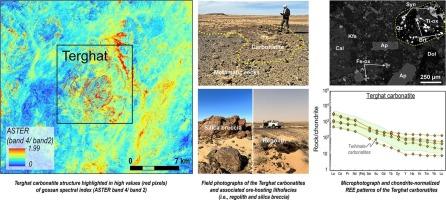New annular carbonatite-derived Fe-REE-Nb ore structure in southern Morocco: Unveiling a large alkaline province in NW Africa
IF 3.6
2区 地球科学
Q1 GEOLOGY
引用次数: 0
Abstract
Owing to their natural affinity to concentrate critical metals, including rare earth elements (REE), carbonatite rocks and their weathering products constitute economically important exploration targets. Linked to a growing demand driven by new green technologies, cratonic margins have increasingly undergone prospection for such critical metal deposits. This study presents a new carbonatite occurrence in the peri-cratonic terrain of the Reguibat Shield (Morocco). This recently discovered Terghat structure, with its wide and distinctive, ring-shaped outcrops (Ø = 9.5 km), is covered by both extensive regolith and silica breccia rocks. Rare outcropping carbonatites comprise calcite carbonatites with subordinate apatite, Fe-oxides, and phlogopite, with minor carbocernaite, synchysite, and ancylite as principal REE-bearing phases. Together with whole-rock trace element profiles, these features are strikingly similar to those observed in ring-shaped structures of the Twihinate-Lamlaga-Lahjayra (TLL) complex, within the western Oulad Dlim Massif. Such similarities are suggestive of a genetic link between the Terghat carbonatite and Cretaceous alkaline magmas of the TTL complex. Thick Fe-oxide/hydroxides bearing regolith also resemble carbonatite-derived regolith with total rare earth element oxide (TREO) and Nb2O5 enrichment (up to ∼ 3.7 % and 3.5 %, respectively), associated with crandallite-group minerals, monazite, and supergene residual pyrochlore. The silica breccia is also crosscut by monazite-rich veins and hydrothermally altered pyrochlore, linked to intense metasomatism affecting pre-existing quartzitic rocks. In spite of their different mineralogy, these lithofacies display similar REE fractionation with high LREE enrichment, inherited from underlying carbonatites. Accordingly, both hydrothermal alteration and subsequent weathering have played an important role in the redistribution of critical elements and metal deposition. As observed, the Terghat structure represents a new opportunity to investigate carbonatite-related critical element enrichment through sub-solidus processes. It also offers a promising link to broader alkaline magmatic activity and underscores the potential for future discoveries of REE and other critical mineral deposits in NW West African Craton margin.

摩洛哥南部新的环状碳酸盐衍生的Fe-REE-Nb矿结构:揭示了西北非洲的一个大碱性省
碳酸盐岩及其风化产物具有富集稀土等关键金属的天然亲和性,是经济上重要的勘探目标。由于新的绿色技术驱动的需求不断增长,克拉通的边际越来越多地经历了这种关键金属矿床的前景。本文介绍了在摩洛哥瑞吉巴特地盾克拉通周围地区发现的一种新的碳酸盐岩产状。这个最近发现的Terghat结构,其宽阔而独特的环状露头(Ø = 9.5公里),被广泛的风化层和硅角砾岩覆盖。稀有的露头碳酸盐由方解石碳酸盐组成,其次是磷灰石、氧化铁和云母,少量的碳铈矿、合长石和云母为主要的含稀土相。结合整个岩石的微量元素剖面,这些特征与在奥拉德·德利姆地块西部的twihinat - lamlaga - lahjayra (TLL)复合体的环状结构中观察到的特征惊人地相似。这种相似性暗示了Terghat碳酸盐岩与TTL复合体的白垩系碱性岩浆之间的遗传联系。厚的含铁氧化物/氢氧化物的风化层也类似于碳酸盐岩衍生的风化层,总稀土元素氧化物(TREO)和Nb2O5富集(分别高达~ 3.7%和3.5%),与辉长石群矿物、独居石和表生残余焦绿石相关。石英角砾岩也被富含独居石的矿脉和热液蚀变的焦绿石横切,这与影响原有石英岩的强烈交代作用有关。这些岩相虽然矿物学不同,但继承了下伏碳酸盐岩,稀土元素分馏相似,富集程度高。因此,热液蚀变和随后的风化作用对关键元素的重新分配和金属沉积起了重要作用。由此可见,Terghat构造为通过亚固相过程研究碳酸盐岩相关的关键元素富集提供了新的机会。它还为更广泛的碱性岩浆活动提供了有希望的联系,并强调了未来在西北西非克拉通边缘发现稀土元素和其他重要矿床的潜力。
本文章由计算机程序翻译,如有差异,请以英文原文为准。
求助全文
约1分钟内获得全文
求助全文
来源期刊

Ore Geology Reviews
地学-地质学
CiteScore
6.50
自引率
27.30%
发文量
546
审稿时长
22.9 weeks
期刊介绍:
Ore Geology Reviews aims to familiarize all earth scientists with recent advances in a number of interconnected disciplines related to the study of, and search for, ore deposits. The reviews range from brief to longer contributions, but the journal preferentially publishes manuscripts that fill the niche between the commonly shorter journal articles and the comprehensive book coverages, and thus has a special appeal to many authors and readers.
 求助内容:
求助内容: 应助结果提醒方式:
应助结果提醒方式:


